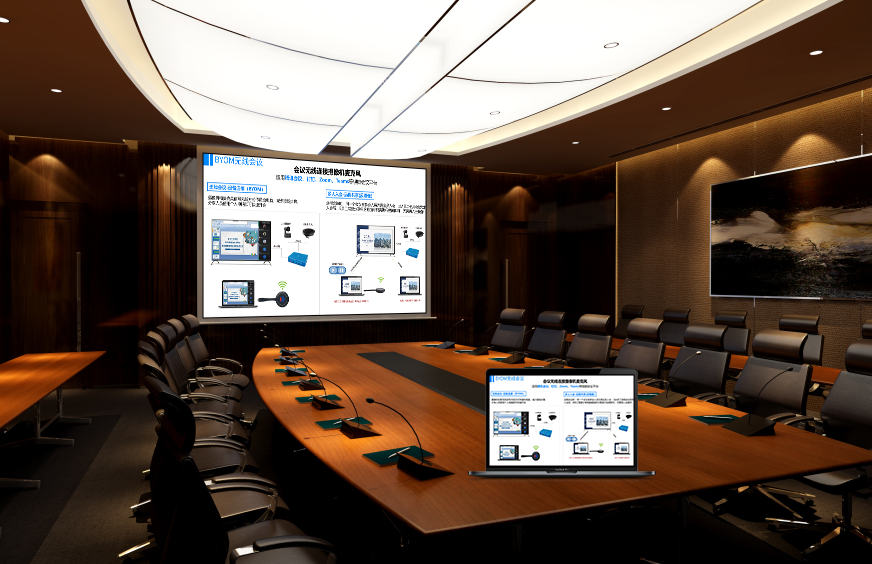Use This for Google Cast: A Smoother Experience for Google Devices
Are you a Google ecosystem user looking to effortlessly connect your Chromecast, Android device, or Chrome browser to a big screen? This screen mirroring device is the perfect fit! It’s deeply compatible with the native Google Cast protocol, requiring no complex setup and enabling seamless cross-device content flow with a single click. It covers office collaboration, home entertainment, and educational interaction, making multi-screen collaboration within the Google ecosystem more effortless and efficient.
2 Steps to Start Google Cast Collaboration: A Zero-Hurdle for Google Users
This device perfectly aligns with Google’s user habits, so you can get started right away:
- Quick Hardware Connection: Plug the receiver into your large screen (TV / meeting display / projector). Once powered on, the large screen will show a dedicated Google Cast name (e.g., “Living Room Cast Screen,” “Conference Room Google Linkage Screen”). Connect your Chromecast, Android phone/tablet, and Chrome browser to the same Wi-Fi as the device—no extra plugins are needed.
- One-Click Casting: On your Android device, swipe down from the top of the screen to open the quick panel and tap the “Cast” icon. On your Chrome browser, click the “three dots” in the top right corner and select “Cast.” Choose the corresponding large screen name to connect in just 1 second. The content synchronizes in real-time, and the operation is seamlessly integrated with native Google functions, so even a beginner can master it instantly.
Core Advantages: More Flexible Multi-Screen Interaction in the Google Ecosystem
Cross-Device Compatibility, Covering the Entire Ecosystem
- All-Device Adaptation: This device is perfectly compatible with the Chromecast series (Chromecast with Google TV, Chromecast Ultra), Android 6.0+ phones/tablets (Samsung, Google Pixel, OnePlus, etc.), and Windows/macOS computers with Chrome browsers. The adaptation rate is over 98%, ensuring seamless collaboration for your Google ecosystem devices.
- Seamless Cross-System Use: It supports casting from Android devices to a large screen, documents from a Chrome browser, and relay casting through a Chromecast, breaking down device type limitations. Your phone, computer, and TV can work together smoothly without you needing to switch tools due to different operating systems.
- Native Operation with No Learning Curve: It uses the same native Google Cast logic, so users familiar with Chromecast don’t need to re-adapt. Simply open the familiar “Cast” entry to mirror your screen. It’s easy enough for kids and seniors to use.
High-Efficiency Content Flow, Smoother Experience
- Instant Material Sharing: An online document or cloud PPT open in your Chrome browser can be mirrored to a large screen via Google Cast while you edit it on your computer. The content syncs in real-time. Photos taken during a meeting on your Android phone can be instantly cast to the large screen and automatically saved to your Chrome browser device, boosting material collection efficiency by 60%.
- Smoother Streaming: Use Google Cast from your Chrome browser to stream videos from platforms like YouTube and Netflix to the large screen, which directly handles the decoding. This ensures no lag in 4K playback and precise audio-visual synchronization. You can also cast local movies from your Android phone, with support for fast-forwarding or episode selection, while you simultaneously browse comments on your phone without interrupting playback.
- Full Format Compatibility: Supports mainstream formats like PPT, PDF, MP4, MKV, and JPG. Files on your Google devices can be pushed via Google Cast without conversion. Playback is smooth without crashing, adapting to 99% of office and entertainment materials.

All-Scenario Adaptability: Fulfilling All Google Cast Interaction Needs
Office Collaboration: Efficient Google Device Linkage
- During project discussions, a designer can project a draft from their Chrome browser device (master) to the large screen, while a product manager uses an Android tablet (auxiliary) to annotate revisions. The revisions are synced in real-time to the computer and the large screen, eliminating the need to pass devices around. In remote meetings, an off-site colleague can use a Chromecast device to mirror their report, while the local team uses an Android phone to annotate key points, ensuring seamless online and offline collaboration.
- In a signing scenario, a Chrome browser device can project a contract to the large screen for both parties to review. The client can use an Android phone (auxiliary device) to electronically sign, with the signature instantly displayed on the large screen and the computer document, making the entire process efficient and professional while aligning with Google ecosystem habits.
Home Entertainment: Sharing Quality Time for Google Users
- During family time, a Chrome browser device can project an educational animation to the TV, while a parent uses an Android tablet (auxiliary) to open interactive exercises. Children learn while watching, and their answers are submitted to the computer for grading, seamlessly blending learning and entertainment.
- At family gatherings, friends and family can take turns pushing photos and short videos from their Android phones to the TV via Google Cast. The Chrome browser device can simultaneously create a digital photo album, paired with background music played via Google Cast Audio, making the sharing atmosphere more lively.
- When watching movies or playing games, an Android phone can cast a mobile game to the TV, with a Chrome browser device acting as a “game controller.” Low-latency transmission ensures smooth, responsive actions, and you can team up with friends for more fun. This division of labor among Google devices makes the experience more immersive.
Educational Interaction: Activating the Classroom with Google Devices
- A teacher can use an Android tablet (master) to cast a lesson plan to the large screen via Google Cast, using a stylus to make real-time annotations that sync to students’ Android devices. When using a 3D teaching model, Google Cast automatically optimizes to fit the large screen ratio, making abstract knowledge more concrete and helping students understand concepts more deeply.
- Students can cast their homework or problem-solving ideas from their Chrome browser devices for the whole class to review. In a lab class, an Android phone can capture experiment details and magnify them to the large screen via Google Cast, while a Chrome browser device projects a document with experiment principles. This multi-screen combination makes key points easier to understand and boosts classroom engagement by 50%.
Secure and Stable: Confidence for Google Users
- Permission Control: An administrator can set a Google Cast password or a device whitelist, allowing only authorized Google devices to connect, preventing unrelated content from disrupting meetings or classes.
- Stable Transmission: Using dual-band transmission technology (2.4GHz + 5.8GHz), Google Cast mirroring remains stable even in crowded environments. Latency is ≤15ms, and the disconnection rate is less than 0.1%, so it won’t fail during critical moments.
- Portable and Lightweight: The device is palm-sized and weighs less than 50g, so it can easily be slipped into a Google device bag for business trips or outdoor teaching, allowing you to set up a Google Cast collaboration scenario anytime, anywhere.
- Automatic Adaptation and Updates: The device regularly syncs with Google system updates, ensuring Google Cast functions remain stable on new Android and Chrome browser versions without manual debugging. It’s built for long-term, hassle-free use.
Whether you’re a heavy Google ecosystem user or just someone who occasionally needs multi-screen interaction, using this device to enable Google Cast provides the convenience and stability of native integration. It makes the connection between your Chromecast, Android device, and Chrome browser with a large screen smoother, easily unleashing the full value of Google’s multi-screen capabilities.